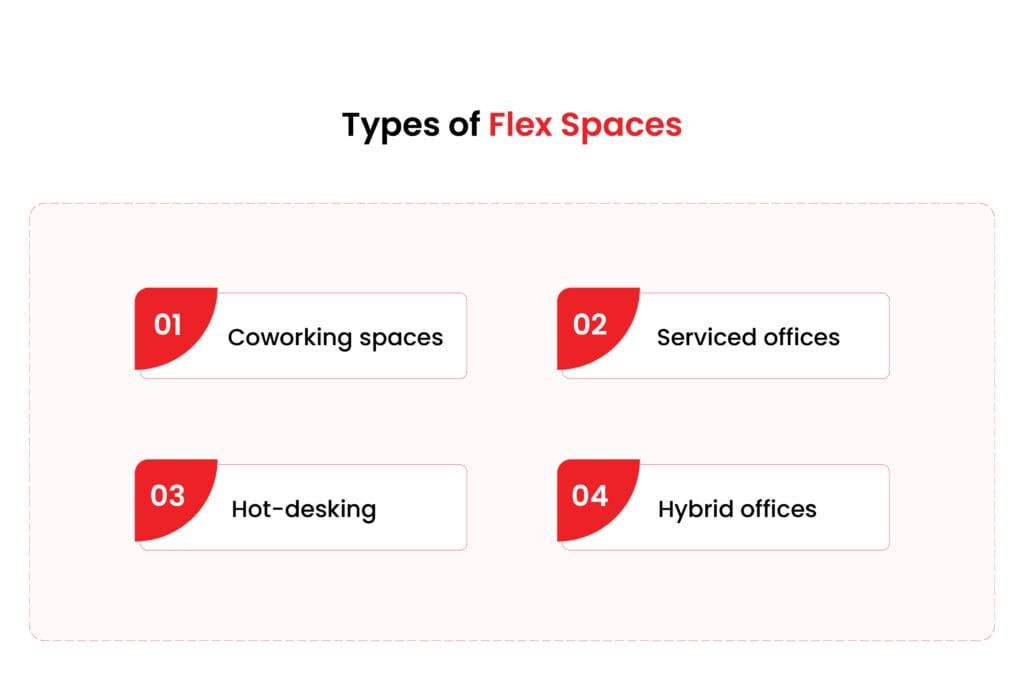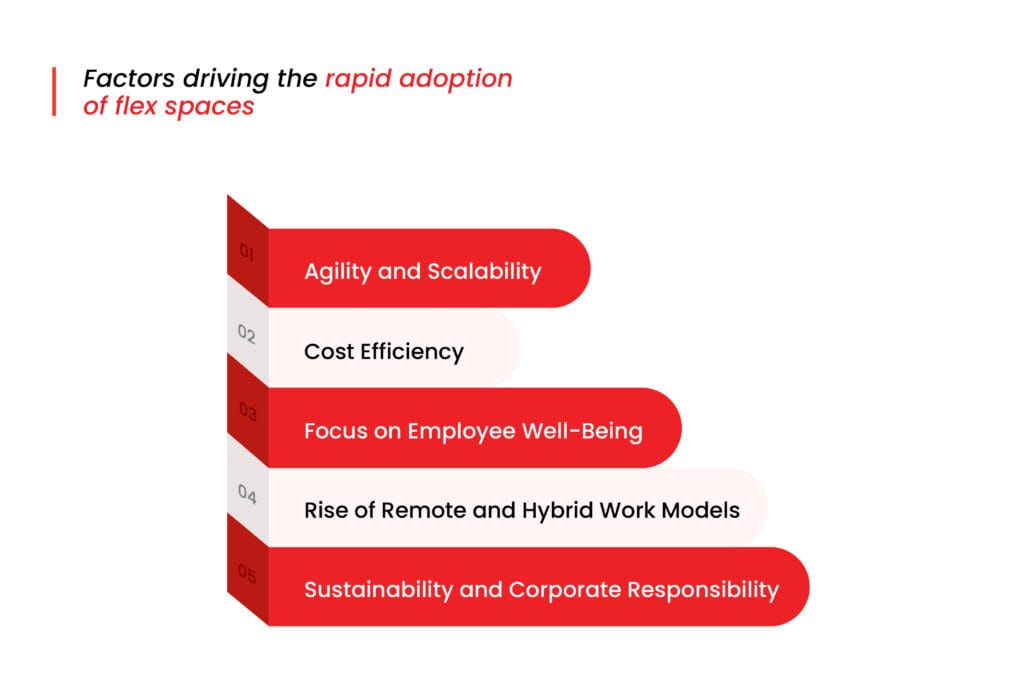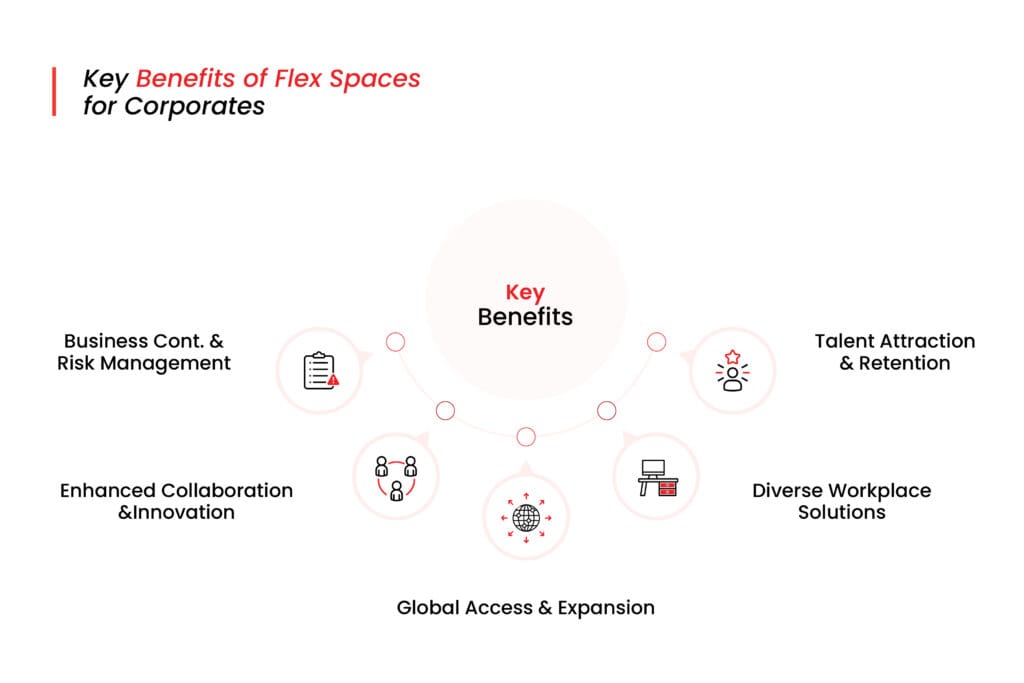In the fast-paced world of corporate real estate, flexibility is no longer a luxury—it’s a necessity. The traditional office space model, where companies lease large spaces for long periods, is being redefined by the increasing demand for flex spaces in corporate real estate. Flexible workspaces, also known as flex spaces, offer businesses the agility to scale operations without the constraints of conventional leases. Whether it’s short-term leases, coworking spaces, or tailored office solutions, flex spaces are now integral to modern workplace strategies.
What Are Flex Spaces?
Flex spaces refer to workspaces that allow businesses to adjust their space requirements based on their needs. Unlike traditional office spaces, where leases might extend for five to ten years, flex spaces provide shorter, more adaptable leasing terms. These spaces are typically designed with modular infrastructure that can be easily reconfigured, supporting varying business demands.
Following are the types of flex spaces :

Coworking spaces: Shared office environments where businesses, freelancers, and remote workers operate.
Serviced offices: Fully-equipped private offices available for short-term or long-term use.
Hot-desking: Flexible seating where employees or teams can use available desks rather than having fixed workstations.
Hybrid offices: A mix of traditional office setups and flexible areas to accommodate in-office and remote employees.
Why Flex Spaces Are Gaining Popularity

Several factors are driving the rapid adoption of flex spaces:
Agility and Scalability
As businesses face an ever-evolving economic landscape, the ability to adjust space requirements in real-time is critical. For example, startups and scaling companies often experience growth or contraction at an unpredictable rate. Flex spaces allow them to increase or decrease their office footprint with minimal financial risk.
Cost Efficiency
Traditional office leases come with hefty costs, including long-term commitments, fit-out expenses, and maintenance fees. On the other hand, flex spaces come pre-furnished, and utilities are often included in the rent, making them a cost-effective solution. This is particularly appealing for small-to-medium enterprises (SMEs) and companies looking to minimize overhead costs.
Focus on Employee Well-Being
The modern workforce prioritizes work-life balance, and flex spaces are designed with well-being in mind. From wellness rooms to green spaces and ergonomic furniture, these workspaces are built to enhance productivity while supporting mental and physical health. As businesses seek to attract and retain top talent, offering comfortable and flexible office environments can be a competitive advantage.
Rise of Remote and Hybrid Work Models
The COVID-19 pandemic accelerated the adoption of remote and hybrid work models. While many employees now work from home, businesses still need physical office spaces for collaboration, meetings, and team-building activities. Flex spaces provide a solution that meets these changing demands, offering hybrid models that blend remote and in-office work environments seamlessly.
Sustainability and Corporate Responsibility
Sustainability has become a key concern for companies worldwide, and flex spaces contribute to reducing a company’s carbon footprint. These spaces are often designed with energy efficiency in mind, utilizing green building materials and smart technology to reduce waste and optimize resource usage. This aligns with the growing trend of corporate responsibility, where businesses prioritize environmentally friendly solutions.
Market Growth and Data Trends in Flex Spaces
The demand for flex spaces has seen exponential growth globally, with significant trends emerging, particularly in key markets like the U.S., India, and across Europe. According to a recent report from Colliers International, the flexible office space market is poised for substantial growth, driven by increased demand from businesses of all sizes.
Flex Spaces in India

India has become one of the fastest-growing markets for flex spaces, with major cities like Bengaluru, Pune, and Hyderabad leading the charge. Flex space stock in India is expected to cross 80 million square feet by 2026, making up a growing share of the total office space market.
Bengaluru currently accounts for the largest portion of flex space in India, with 34% of the country’s total flex stock. This is followed by Pune, where flex spaces are penetrating traditional office markets at a rate of 8.9%.
As of 2023, flex spaces in India represent approximately 6.3% of the total office space market. By 2026, this figure is projected to grow as companies continue to embrace hybrid work models.
Global Flex Space Trends
The global flex space market is expected to grow at an annual rate of 7.2% over the next five years.
The Asia-Pacific (APAC) region has witnessed a massive boom in flex space demand, with countries like China, Singapore, and India becoming hotspots for coworking and serviced office spaces.
In the U.S., the adoption of flex spaces is being led by tech companies and startups, many of which are gravitating towards flexible office solutions to accommodate hybrid workforces.
Europe is also seeing significant growth, particularly in major hubs like London, Paris, and Berlin, where coworking spaces have become an essential part of the corporate landscape.
Key Benefits of Flex Spaces for Corporates

Business Continuity and Risk Management
Flex spaces provide businesses with the agility to adapt quickly to unforeseen challenges, such as economic downturns, global pandemics, or rapid shifts in the market. By offering short-term leases and modular setups, flex spaces enable companies to reduce long-term commitments and quickly adjust their space usage without the financial burden associated with traditional office leases.
Enhanced Collaboration and Innovation
Many companies find that flex spaces foster greater collaboration and creativity among employees. The open and adaptable nature of these workspaces encourages cross-functional teamwork and brainstorming sessions, while dedicated breakout areas and private rooms allow for focused work.
Global Access and Expansion
Flex spaces are often part of a global network, allowing companies to establish a presence in multiple locations without the need for physical offices in every city. This is particularly valuable for companies with a dispersed workforce or those looking to expand into new markets.
Diverse Workplace Solutions
Flex spaces offer a wide range of work settings, from private offices and meeting rooms to open lounges and hot-desking options. This diversity ensures that employees can choose the work environment that best suits their needs, promoting productivity and job satisfaction.
Talent Attraction and Retention
In a competitive talent market, offering flexibility in the workplace can be a powerful tool for attracting and retaining top talent. Companies that provide access to modern, comfortable flex spaces often see higher levels of employee engagement, job satisfaction, and retention.
Challenges of Flex Spaces
While flex spaces offer numerous benefits, they also come with certain challenges:
Lack of Long-Term Stability
For businesses that prefer stability, the short-term nature of flex space leases can be a downside. While flexibility is a plus for many, companies with long-term strategic goals may still prefer traditional office leases.
Customization Limitations
Flex spaces are designed for quick turnover and modular use, meaning they may not offer the same level of customization as a traditional office. This can be a challenge for companies looking to create a deeply branded, tailored workspace.
Overcrowding in Popular Locations
In key business hubs, flex spaces can become overcrowded, leading to availability issues during peak times. Companies must carefully select providers with enough capacity to meet their needs consistently.
Conclusion: The Future of Flex Spaces in Corporate Real Estate
The future of flex spaces in corporate real estate is bright. As businesses continue to prioritize agility, cost-efficiency, and employee well-being, the demand for flexible workspaces will only increase. Flex spaces are more than just a trend—they are a fundamental shift in how companies approach office space, offering a solution that meets the needs of a dynamic, ever-changing business world.
As Real estate experts predict, flex spaces are set to take an even larger share of the market in the coming years. Businesses that embrace these modern workplace solutions will not only reduce costs and improve productivity but also position themselves at the forefront of a new era in corporate real estate. Start your journey to a smarter office space today and see the difference it makes. Contact us or mail us at hello@91sqft.com


